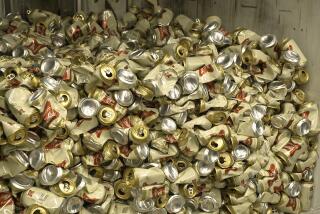Beer Sales Got First Head of Steam in 1934
Question: I have a beer can collection that goes back to World War II. How much farther back do I have to go to get to the year when the first beer cans were produced?--L.F.
Answer: You’re almost there. The first patent for a plastic-lined steel can was issued to the American Can Co. in September, 1934.
Then, the first company to take advantage of the new marketing brainstorm was the Gotfried Krueger Brewing Co. of Newark, N.J., which marketed Krueger’s Finest Beer and Krueger’s Cream Ale in a 12-ounce can.
The valuable Krueger can featured its “K-man”--a bellhop carrying a tray holding two cans of beer, a design Kruger used until about a year into World War II. Just one original Krueger can, collectors say, can sell for several hundred dollars.
(Some Krueger cans came with a triangular-bladed opener, which, in its own right, has become a collectible item.)
Krueger’s sales boomed and, taking notice, larger brewers--Pabst appears to be the first major one--looked kindly upon the beer can to quickly open up new markets.
Before Prohibition, beer usually was stored and shipped in kegs and then sold in returnable bottles. When Prohibition ended in December, 1933, breweries were looking for a quick way to distribute their product in a container that would allow beer to be stored longer. Hence, the beer can was born.
The year 1935 appears to be an innovative one for the beer can. That year, Continental Can Co. introduced the cone-top beer can, and Schlitz appears to have been the first brewery to take advantage of this design.
The next major innovation didn’t appear until 1962, when the aluminum pop-top can was introduced by several can producers.
Before you pay a lot of cash for these early cans, make sure they’re in good condition, or veteran collectors won’t give them a second glance. Cans with dents or rust just don’t command much interest.
Many collectors say they open collectible beer cans from the bottom to let out the liquid refreshment without disturbing the top, which may feature opening devices that will allow the collector to approximately date the can’s production.
Aside from collecting cans that depict the beer industry’s history, collectors also look for contemporary local labels in this country and abroad. It’s a quick and relatively inexpensive way to expand your collection.
Other collectors look not only for rare cans but also for those that display outstanding and colorful labeling art. For example, Japanese breweries, such as Asahi and Suntory, with their beautiful nature photographs, are in this category.
More to Read
Eat your way across L.A.
Get our weekly Tasting Notes newsletter for reviews, news and more.
You may occasionally receive promotional content from the Los Angeles Times.










